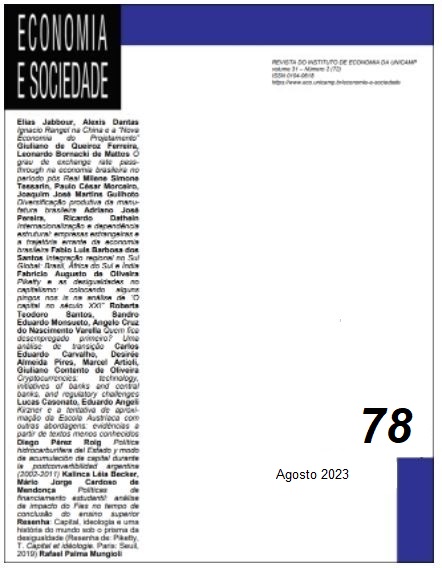Abstract
The purpose of this article is to contribute to the debate on the performance of the Brazilian economy in the 21st century, focusing on the period from 2011 to 2019 characterized by low growth rates. To that end, a growth decomposition is calculated based on the Sraffian Supermultiplier model, taking as the methodology adopted by Freitas and Dweck (2013) a reference and using the data from the System of National Accounts for the period from 2000 to 2019. Although this growth decomposition is not a test which aims to validate the Sraffian Supermultiplier model, the results suggest that the stylized facts of the Brazilian economy are in accordance with what is expected by the theoretical model. I also present some explanations from the heterodox field about the Brazilian economic performance during the last decade, demonstrating how each of these explanations can be compatible with the Supermultiplier model approach and analyze which were more important to explain the Brazilian economic performance during the period under analysis.
References
BRAGA, J. Investment rate, growth, and the accelerator effect in the supermultiplier model: the case of Brazil. Review of Keynesian Economics, v. 8, n. 3, p. 454-466, 2020. Disponível em: https://doi.org/10.4337/roke.2020.03.08.
CARNEIRO, R. Navegando a contravento: uma reflexão sobre o experimento desenvolvimentista do governo Dilma Rousseff. In: CARNEIRO, R.; BALTAR, P.; SARTI, F. (Org.). Para além da política econômica. São Paulo: Editora Unesp, 2018, cap. 1, p. 11-54. Disponível em: https://www.eco.unicamp.br/images/arquivos/para-alem-da-politica-economica.pdf. CESARATTO, S.; SERRANO, F.; STIRATI, A. Technical change, effective demand and employment. Review of Political Economy, v. 15, n. 1, p. 33-52, 2003. Disponível em: https://doi.org/10.1080/09538250308444. CHERNAVSKY, E.; DWECK, E.; TEIXEIRA, R. A. Descontrole ou inflexão? A política fiscal do governo Dilma e a crise econômica. Economia e Sociedade, v. 29, p. 811-834, 2020. Disponível em: https://doi.org/10.1590/1982-3533.2020v29n3art06. FEVEREIRO, J. B. R. T. Decomposição da taxa de crescimento do PIB pelo lado da demanda: uma metodologia alternativa. Carta de Conjuntura IPEA, abr. 2016 Disponível em: https://www.ipea.gov.br/portal/images/stories/PDFs/conjuntura/160627_carta_conjuntura30_nota_tecnica_2.pdf.
FREITAS, F.; DWECK, E. The pattern of economic growth of the Brazilian economy 1970-2005: a demand-led growth perspective. In: LEVRERO, E. S.; PALUMBO, A.; STIRATI, A. (Ed.). Sraffa and the reconstruction of economic theory. London: Palgrave Macmillan, 2013. v. 2, cap. 7, p. 158-191. FREITAS, F.; SERRANO, F. Growth rate and level effects, the stability of the adjustment of capacity to demand and the Sraffian supermultiplier. Review of Political Economy, v. 27, n. 3, p. 258-281, 2015. Disponível em: https://doi.org/10.1080/09538259.2015.1067360.
LIMA, P.; PIMENTEL, D.; BASTOS, C. Crédito pessoal no Brasil e a importância do emprego formal. In: SEMINÁRIO DE DIAMANTINA, 18, 2019, Diamantina. Disponível em: https://diamantina.cedeplar.ufmg.br/portal/download/diamantina-2019/D18_87.pdf. MARCONI, N. O papel dos preços macroeconômicos na crise e na recuperação. Estudos Avançados, v. 31, p. 97-109, 2017. Disponível em: https://doi.org/10.1590/s0103-40142017.31890011. MARTINS, G. K.; RUGITSKY, F. The long expansion and the profit squeeze: output and profit cycles in Brazil (1996–2016). Review of Radical Political Economics, v. 53, n. 3 p. 373-397, 2021. Disponível em: https://doi.org/10.1177%2F0486613420982083.
MELLO, G.; ROSSI, P. Do industrialismo à austeridade: a política macro dos governos Dilma. In: CARNEIRO, R.; BALTAR, P.; SARTI, F. (Org.). Para além da política econômica. São Paulo: Editora Unesp, 2018, cap. 7, p. 245-282. Disponível em: https://www.eco.unicamp.br/images/arquivos/para-alem-da-politica-economica.pdf. MIGUEZ, T. Evolução da formação bruta de capital fixo na economia brasileira 2000-2013: uma análise multissetorial com base nas Matrizes de Absorção de Investimento (MAIs). 2016. Tese (Doutorado em Economia)–Instituto de Economia, Universidade Federal do Rio de Janeiro, Rio de Janeiro, 2016. Disponível em: https://www.ie.ufrj.br/images/IE/PPGE/teses/2016/Thiago%20de%20Holanda%20Lima%20Miguez.pdf. MIGUEZ, T.; FREITAS, F. Matrizes de Absorção de Investimento: proposta metodológica para o SCN Ref. 2010 (No. Provisório, em elaboração). Rio de Janeiro: BNDES, 2019. OLINTO, R.; CONSIDERA, C.; TRECE, J.; SOUZA, A. O mistério das plataformas fantasmas. Blog do IBRE, 2021. Disponível em: https://blogdoibre.fgv.br/posts/o-misterio-das-plataformas-fantasmas. PADRÓN, A.; SANTOS, C. H.; AMITRANO, C.; RIBEIRO, F.; BHERING, G. Por que a elasticidade-preço das exportações é baixa no Brasil? Novas evidências desagregadas. In: MELLO E SOUZA, A.; MIRANDA, P. (Ed.). Brasil em desenvolvimento 2015: Estado, planejamento e políticas públicas. Ipea, 2015, cap. 1, p. 15-42. Disponível em: http://repositorio.ipea.gov.br/handle/11058/5862. ROSSI, P.; MELLO, G. Choque recessivo e a maior crise da história: a economia brasileira em marcha à ré. In: TEIXEIRA, L.; BASTOS, P. P. Z. Conjuntura, estrutura e teoria – o capitalismo contemporâneo nas análises do Cecon (2017-2021). Campinas: Editora CRV Ltda, 2021. cap 1, p. 17-27.
SARTI, F.; HIRATUKA, C. Desempenho recente da indústria brasileira no contexto de mudanças estruturais domésticas e globais. In: CARNEIRO, R.; BALTAR, P.; SARTI, F. (Org.).Para além da política econômica. São Paulo: Editora Unesp, 2018, cap. 4, p. 127-170. Disponível em: https://www.eco.unicamp.br/images/arquivos/para-alem-da-politica-economica.pdf. SERRANO, F.; BRAGA, J. O mito da contração fiscal expansionista nos EUA durante o governo Clinton. Economia e Sociedade, v. 15, n. 2, p. 213-239, 2006. Disponível em: https://periodicos.sbu.unicamp.br/ojs/index.php/ecos/article/view/8642908. SERRANO, F.; FREITAS, F.; BHERING, G. The trouble with Harrod: the fundamental instability of the warranted rate in the light of the Sraffian Supermultiplier. Metroeconomica, v. 70, n. 2, p. 263-287, 2019. Disponível em: https://doi.org/10.1590/0103-6351/3549. SERRANO, F.; SUMMA, R. Aggregate demand and the slowdown of Brazilian economic growth in 2011-2014. Nova Economia, v. 25, p. 803-833, 2015. Disponível em: https://doi.org/10.1590/0103-6351/3549. SERRANO, F.; SUMMA, R. Conflito distributivo e o fim da “breve era de ouro” da economia brasileira. Novos Estudos Cebrap, v. 37, p. 175-189, 2018. Disponível em: https://doi.org/10.25091/S01013300201800020002.

This work is licensed under a Creative Commons Attribution-NonCommercial 4.0 International License.
Copyright (c) 2023 Economia e Sociedade


